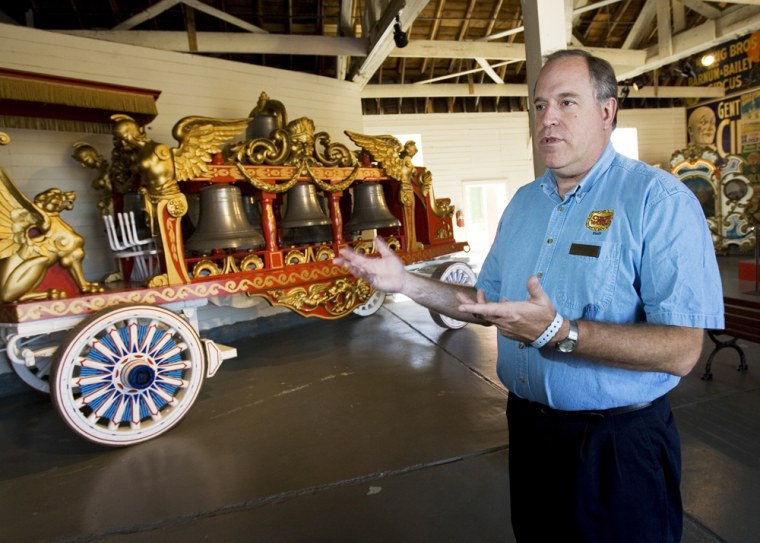Not long ago, the Circus World Museum seemed to be falling like a trapeze artist without a net.
Tourists were abandoning this small town, where Ringling Brothers got its start, largely because of the end of the annual circus parade that helped fund the museum. But now the museum might be saved, thanks to savvy fundraising, operational finesse, and a former state lawmaker who ran off to join the circus — or at least the circus museum.
The museum, which opened in 1959, spans a 63-acre site that served as the winter home of the Ringling brothers' circus from 1884 to 1918.
Its permanent collection, housed in many of the original buildings built by the Ringlings, includes the world's largest collection of authentic circus wagons, a circus train exhibit, and a 42-year-old library and research center.
"The things I've got are basically one of a kind," said archivist Erin Foley, pulling out one unique vintage circus poster after another.
Visitors enter the museum to the sound of circus music and see such sights as vintage wagons and posters advertising such attractions as Gargantua, the giant gorilla.
Outside the museum are original Ringling-built buildings and the Hippodrome where circus acts perform all summer. There are elephants and camels to ride, popcorn and cotton candy to eat, photos and costumes of famous clowns and performers, and an interactive circus where children can be a part of the show.
"Disney World is wonderful and all of that. But what Circus World Museum has is the real thing," said Renee Boldt, chairwoman of the Circus World Museum Foundation Board of Directors.
The museum once seemed likely to fold up its tent. By the end of 2005, due mainly to the end of the parade, Circus World had just $500 in its checking account and was $300,000 in debt.
For more than a generation, every summer the old circus wagons would be brought out of storage to form an old-fashioned circus train that traveled 150 miles east from Baraboo to Milwaukee for a 1900s-style parade featuring clowns, animals and marching bands.
Money raised from the parade, which attracted thousands of people, helped keep Circus World alive.
When Milwaukee organizers failed to come up with money for the parade, it moved to Baraboo. Funding plummeted, as did attendance at Circus World. From 1999 to 2006, attendance dropped 68 percent, and last year, Circus World turned a meager profit of just over $64,200.
But there are signs of improvement. A recent fundraiser brought a profit of more than $148,000, and attendance so far is up 25 percent over 2006, said Circus World director Steve Freese.
Freese took the job in January after losing a re-election bid following 16 years in the state Assembly. He's tapped his contacts statewide to help with fundraising.
Freese has lowered food prices and even stuffed more cotton candy into bags to give guests better deals.
Recent visitor Betsy Dukatz, 39, of New Berlin, Wis., was impressed.
"It's something in our own backyard and you don't even really know about it," said Dukatz, who brought her two children along.
Circus World struggled over the years with whether to emphasize the museum's history or to compete for vacationers who flock to water parks and attractions in the nearby Wisconsin Dells.
For scholars like Janet Davis, who did her graduate work at the University of Wisconsin-Madison and frequently drove to the museum for research, the choice is clear.
"The library at Circus World is just a huge trove of information," Davis said. "It's just this incredible insight into the day-to-day life of the circus 100 years ago."
Davis, professor of American Studies at the University of Texas at Austin and author of "The Circus Age: Culture and Society Under the American Big Top," said she is grateful the museum's collection appears more likely to remain intact.
"For this to be closed or parceled off to other collections, that would be a great tragedy," she said.
David SaLoutos sold popcorn as a high schooler at Circus World in 1973, and has since worked there in such jobs as ringmaster, maintenance man and musician. He remembers the dark period when the staff dwindled from 30 to the current seven, but says he is optimistic about life in the area known as Ringlingville.
"It feels a lot more positive," he said as about 200 visitors watched a live performance by Chinese acrobats. "I feel we're on the move."
